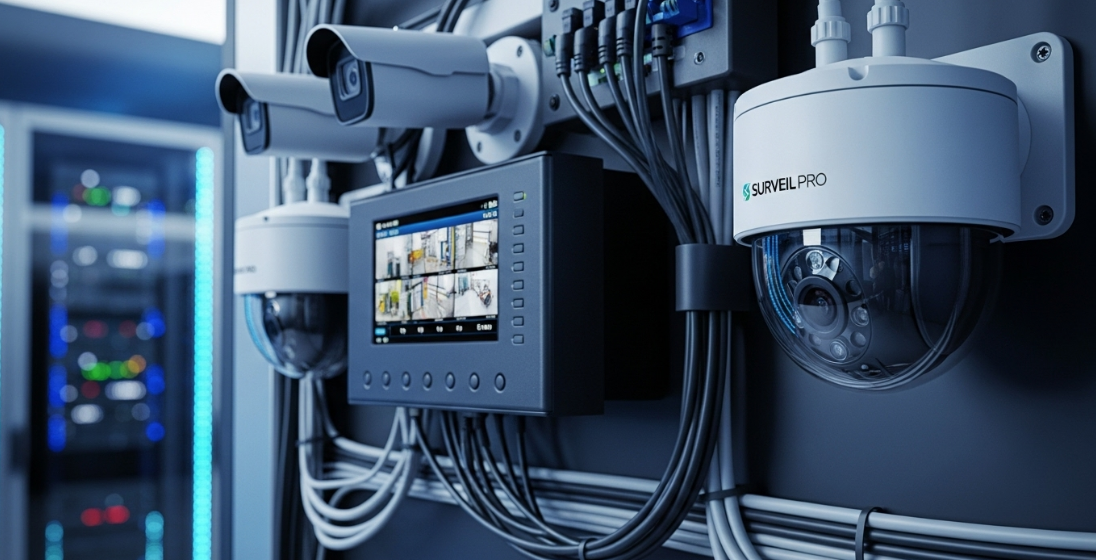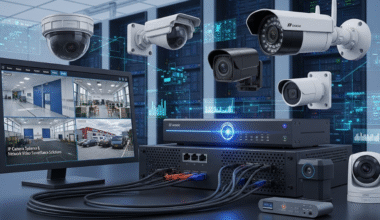The Digital Revolution in Security: Why IP Surveillance Dominates Modern Protection
The surveillance industry has undergone a fundamental transformation over the past decade. Traditional analog systems—once the standard for security monitoring—have been rapidly displaced by Internet Protocol (IP) camera technology that delivers superior image quality, advanced intelligence, and operational flexibility impossible with legacy equipment. For organizations and homeowners planning new surveillance deployments or considering system upgrades, understanding IP surveillance advantages isn’t optional—it’s essential to making informed investment decisions that deliver lasting value.
What IP Surveillance Actually Means: Technology Fundamentals
IP cameras function fundamentally differently than their analog predecessors. Rather than transmitting analog video signals over coaxial cables to dedicated recording equipment, IP cameras are sophisticated network devices that capture, digitize, and transmit video data over standard computer networks using Internet Protocol—the same technology powering email, web browsing, and all internet communications.
This architectural difference creates cascading advantages affecting every aspect of surveillance system performance, capability, and value delivery.
Core Technology Advantages:
Digital Native Quality: IP cameras capture video in digital format from the moment light hits the sensor—eliminating the quality degradation inherent in analog-to-digital conversions. This means sharper images, more accurate colors, and greater detail preservation particularly important for facial recognition and evidence collection.
Network Infrastructure Leverage: IP surveillance utilizes existing computer networks rather than requiring dedicated coaxial cabling throughout facilities. This dramatically reduces installation costs in buildings with established network infrastructure while enabling surveillance expansion wherever network connectivity exists.
Distributed Intelligence: Unlike analog systems where intelligence resides solely in central recording equipment, IP cameras contain onboard processors enabling sophisticated analytics, motion detection, and automated responses at the camera level—reducing network bandwidth, improving response times, and enabling smarter security.
Scalability Without Limitations: Analog systems face hard limitations based on DVR input capacity. IP surveillance scales virtually infinitely—adding cameras simply requires network capacity and storage, not complete system replacement when expanding coverage.
Remote Accessibility: IP systems enable secure remote viewing from anywhere with internet connectivity, using any device—smartphones, tablets, laptops—transforming surveillance from location-dependent monitoring to truly mobile security management.
Image Quality That Changes Everything: The Resolution Revolution
Perhaps the most immediately apparent advantage of IP surveillance is dramatically superior image quality that transforms surveillance from basic incident documentation to detailed forensic evidence capable of identifying perpetrators, reading license plates, and capturing critical details invisible to analog systems.
Resolution Capabilities:
High Definition Standard: Modern IP cameras deliver 1080p Full HD resolution as baseline—approximately 2 megapixels providing dramatically clearer images than analog’s standard definition roughly 0.4 megapixel equivalent.
4K Ultra HD Options: Premium IP cameras capture 4K resolution—approximately 8 megapixels—delivering extraordinary detail enabling digital zooming into footage without pixelation, facial recognition from greater distances, and evidence quality previously impossible.
Beyond 4K Capabilities: Specialized IP cameras exceed even 4K, with 12-megapixel, 20-megapixel, and higher resolutions available for applications demanding extreme detail—scientific documentation, critical infrastructure monitoring, or panoramic coverage requiring digital zooming across wide fields of view.
Wide Dynamic Range (WDR): Advanced IP cameras handle challenging lighting conditions—bright sunlight and deep shadows simultaneously—producing usable images in scenarios that blind analog cameras with washed-out highlights or impenetrable shadows.
Value of Superior Resolution:
Facial Identification: High resolution enables positive identification of individuals from greater distances and various angles—critical for security investigations, access control verification, and law enforcement cooperation.
License Plate Capture: Clear license plate reading from moving vehicles at reasonable distances requires high resolution and fast shutter speeds—capabilities standard in IP systems but problematic for analog equipment.
Retail Loss Prevention: Detailed imagery captures point-of-sale transactions, product handling, and suspicious behaviors with clarity enabling prosecution and internal investigation—directly impacting shrinkage reduction and profitability.
Evidence Admissibility: Courts increasingly expect high-quality video evidence. Grainy, unclear footage raises reasonable doubt—sharp, detailed IP camera imagery provides compelling evidence supporting legal proceedings.
Area Coverage Efficiency: Single high-resolution IP camera often replaces multiple lower-resolution analog cameras—reducing equipment costs, installation complexity, and maintenance requirements while improving overall coverage.
Intelligent Analytics: Surveillance That Thinks
Beyond passive recording, modern IP cameras incorporate artificial intelligence and video analytics that transform surveillance from reactive evidence collection to proactive security management and operational intelligence.
Advanced Analytical Capabilities:
Smart Motion Detection: AI-powered algorithms distinguish between relevant motion (people, vehicles) and irrelevant movement (swaying trees, lighting changes, small animals)—dramatically reducing false alerts while ensuring genuine security events trigger immediate notification.
Facial Recognition: Advanced IP systems identify known individuals, detect unknown persons, and can integrate with access control databases—enabling automated security responses, attendance tracking, and VIP recognition for hospitality applications.
License Plate Recognition (LPR): Automatic vehicle identification captures and logs license plates of entering and exiting vehicles—valuable for parking management, access control, law enforcement cooperation, and investigative purposes.
Perimeter Intrusion Detection: Virtual tripwires and boundary zones trigger alerts when crossed—enabling early warning of unauthorized access attempts before intruders reach buildings or sensitive areas.
Object Detection and Tracking: Systems identify and follow specific objects (unattended bags, removed items, vehicles) across multiple cameras—useful for theft prevention, security incident response, and operational monitoring.
People Counting and Flow Analysis: Retail and facility management applications benefit from automated visitor counting, queue length monitoring, and traffic pattern analysis—informing staffing decisions, layout optimization, and operational efficiency.
Behavioral Analysis: Advanced systems detect unusual behaviors—loitering, running, crowd formation, aggressive movements—triggering alerts for potential security incidents or safety concerns requiring attention.
Heat Mapping: Aggregate movement data reveals traffic patterns, popular areas, and underutilized spaces—informing retail merchandising, facility design, and resource allocation decisions.
Operational Value of Analytics:
Reduced Monitoring Burden: Rather than requiring continuous human observation of dozens of camera feeds, intelligent systems alert personnel only when specific events occur—enabling small security teams to monitor large facilities effectively.
Faster Incident Response: Automated alerts enable immediate response to developing situations rather than discovering incidents hours later during footage review—potentially preventing losses or mitigating harm through rapid intervention.
Business Intelligence: Analytics transform surveillance from pure security tool to operational asset providing insights into customer behavior, process efficiency, and resource utilization—justifying investment through operational improvements beyond security benefits.
Evidence Retrieval Efficiency: Searching hours of footage for specific events becomes trivial—analytics enable queries like “show me all people who entered the north entrance between 2-4 PM yesterday”—retrieving relevant clips instantly rather than requiring tedious manual review.
Network Video Recorders (NVR): Centralized Intelligence
IP surveillance systems utilize Network Video Recorders (NVR) rather than traditional Digital Video Recorders (DVR)—sophisticated platforms optimized for managing, recording, and analyzing network camera footage.
NVR Advantages:
Flexible Camera Support: NVRs accommodate virtually unlimited cameras from multiple manufacturers (when using standard protocols like ONVIF)—unlike proprietary DVR systems locked to specific camera brands or models.
Distributed Processing: Because IP cameras handle much processing locally, NVRs focus on storage management, footage retrieval, and system administration rather than intensive video processing—enabling more efficient operation.
Network Integration: NVRs function as network devices accessible from any authorized computer—eliminating dedicated monitoring stations and enabling surveillance management from standard IT infrastructure.
Redundancy Options: Enterprise NVRs support RAID storage arrays, failover recording, and backup systems ensuring footage preservation even during equipment failures—critical for high-security applications.
Advanced Search Capabilities: Sophisticated interfaces enable rapid footage retrieval through timeline navigation, event-based searching, and analytical filters—dramatically accelerating investigations.
Multi-Site Management: Centralized platforms manage cameras and NVRs across multiple locations—enabling corporate oversight of distributed facilities through unified interfaces.
Power over Ethernet (PoE): Installation Simplification
One of IP surveillance’s most practical advantages is Power over Ethernet (PoE) technology—delivering both data connectivity and electrical power through single network cables.
PoE Benefits:
Installation Cost Reduction: Eliminating separate electrical wiring for each camera significantly reduces installation labor and materials—particularly valuable in existing buildings where running new electrical circuits requires expensive construction.
Flexibility Enhancement: Cameras install wherever network drops exist—enabling coverage expansion without electrical infrastructure upgrades or complicated power routing.
Centralized Power Management: PoE switches and injectors providing camera power install in central locations (typically alongside network equipment)—enabling efficient UPS backup protection for entire surveillance systems from single locations rather than protecting each camera individually.
Safety Improvement: PoE operates at low voltages (typically 48V DC) safer than line voltage—reducing electrical hazards and relaxing code requirements in some jurisdictions.
Remote Power Control: PoE switches enable remote camera rebooting, power cycling, and management—useful for troubleshooting and maintenance without physical access to cameras.
Cloud Storage and Hybrid Solutions: Storage Revolution
While traditional surveillance exclusively used local storage (DVRs/NVRs), IP systems enable cloud-based and hybrid storage architectures offering distinct advantages for specific applications.
Cloud Storage Benefits:
Off-Site Protection: Cloud storage survives local disasters—fire, flooding, theft—that destroy on-premise recording equipment, ensuring footage preservation regardless of facility conditions.
Remote Accessibility: Cloud-recorded footage accessible from anywhere without configuring complex network access through firewalls—simplifying remote viewing and management.
Scalable Capacity: Cloud storage expands on-demand without hardware purchases—accommodating growing footage libraries or temporary capacity increases without capital investment.
Automatic Redundancy: Cloud providers maintain multiple data copies across geographic locations—providing enterprise-grade data protection impossible to replicate economically with local storage.
Simplified Management: Cloud platforms handle software updates, security patches, and technical maintenance—reducing IT burden particularly valuable for small organizations lacking dedicated technical staff.
Hybrid Approaches:
Local Primary Storage: On-premise NVRs provide immediate access, faster playback, and bandwidth efficiency for day-to-day operations while cloud serves as backup and archive.
Edge Recording with Cloud Backup: Cameras with onboard storage record locally while simultaneously backing up critical footage to cloud—combining local reliability with cloud protection.
Selective Cloud Storage: Only important events or specific cameras send footage to cloud—balancing protection benefits with bandwidth and storage costs.
Cybersecurity Considerations: Protecting Digital Surveillance
IP surveillance’s network connectivity creates cybersecurity responsibilities absent from closed-circuit analog systems. However, these risks are manageable through proper implementation:
Security Best Practices:
Network Segmentation: Isolating surveillance systems on dedicated VLANs prevents compromised cameras from accessing other network resources while protecting cameras from malware spreading through business networks.
Strong Authentication: Changing default passwords, implementing complex credentials, and enabling two-factor authentication prevents unauthorized access to camera feeds and recording systems.
Firmware Updates: Regular security patches address discovered vulnerabilities—maintaining current firmware protects against emerging threats exploiting known weaknesses.
Encryption Implementation: HTTPS connections, encrypted storage, and secure protocols protect footage confidentiality during transmission and storage.
Access Control: Limiting system access to authorized personnel through role-based permissions prevents inappropriate viewing or system tampering.
Reputable Equipment: Quality manufacturers prioritize security through regular updates, vulnerability disclosure, and secure-by-design principles—unlike cheap devices with minimal security consideration.
Integration Capabilities: Unified Security Ecosystems
IP surveillance’s network foundation enables seamless integration with complementary security and business systems—creating unified platforms delivering greater value than standalone components.
Integration Opportunities:
Access Control Systems: Cameras automatically record when doors open, badge readers activate, or access denials occur—linking video documentation with access events for complete security records.
Intrusion Alarm Systems: Camera views automatically display when motion sensors, door contacts, or glass breaks trigger—enabling visual verification and appropriate response.
Video Intercoms: Door stations integrate with surveillance systems—recording all visitors, enabling remote communication, and documenting entry authorization decisions.
Building Management Systems: Environmental sensors, lighting controls, and HVAC systems coordinate with surveillance for energy efficiency and security—lights activate when cameras detect motion in after-hours areas.
Point of Sale Systems: Retail surveillance synchronizes with cash registers—recording transactions, enabling exception-based review, and deterring employee theft through documented accountability.
Analytics Platforms: Surveillance data feeds business intelligence systems—combining video analytics with sales data, staffing levels, and operational metrics for comprehensive insights.
Total Cost of Ownership: Long-Term Value Analysis
While IP cameras often carry higher initial equipment costs than analog alternatives, total cost of ownership analysis reveals compelling economic advantages:
Cost Considerations:
Installation Savings: Reduced cabling requirements (PoE eliminating electrical runs, network infrastructure leverage) significantly decrease installation labor—often offsetting equipment premiums.
Scalability Economics: Adding cameras to IP systems requires only cameras and network switches—not entire DVR replacements necessitated by analog expansion beyond DVR input capacity.
Maintenance Efficiency: Centralized management, remote troubleshooting, and modular replacement reduce ongoing maintenance costs compared to analog systems requiring on-site servicing for most issues.
Future-Proof Investment: IP systems accommodate emerging technologies (improved analytics, higher resolutions, enhanced features) through software updates and camera replacements—avoiding complete system obsolescence typical of proprietary analog systems.
Operational Value: Analytics-driven operational improvements, reduced security staffing requirements, and business intelligence justify investments through benefits extending beyond pure security returns.
Migration Strategies: Transitioning from Analog
Organizations with existing analog surveillance face decisions about system evolution. Hybrid transition approaches enable gradual migration protecting current investments while gaining IP advantages:
Transition Options:
Encoder Solutions: Video encoders convert analog camera signals to IP streams—enabling integration with new NVRs and preserving functional analog cameras during phased transitions.
Hybrid Recorders: Some systems accept both analog and IP cameras—allowing incremental replacement prioritizing high-value locations first while retaining working analog cameras elsewhere.
Parallel Systems: Operating analog and IP systems simultaneously during transition provides redundancy and comparison—building confidence in new technology before complete analog retirement.
Targeted Replacement: Replacing failed analog cameras with IP alternatives gradually transitions systems organically—avoiding large capital expenditures while improving coverage incrementally.
Professional Implementation: Expertise That Matters
IP surveillance’s technical sophistication demands professional implementation ensuring systems deliver promised capabilities rather than becoming expensive disappointments.
Value of Expert Installation:
Network Design: Proper bandwidth calculation, switch selection, VLAN configuration, and quality-of-service implementation ensure reliable video streaming without network congestion or dropped connections.
Camera Selection: Matching camera capabilities (resolution, sensors, lenses, analytics) to specific applications optimizes value—avoiding over-spending on unnecessary features or under-specifying critical capabilities.
Storage Planning: Calculating retention requirements, compression settings, and capacity needs prevents premature storage exhaustion or wasteful over-provisioning.
Cybersecurity Implementation: Proper security configuration protects systems from compromise—requiring expertise beyond basic installation skills.
Integration Execution: Connecting surveillance with access control, alarms, and business systems requires technical knowledge ensuring seamless operation rather than frustrated failure.
User Training: Maximizing system value requires users understand capabilities, operation, and best practices—training converting technology investment into operational advantage.
The Competitive Imperative: Why IP Surveillance Dominates
The surveillance industry has spoken decisively: IP camera systems represent the overwhelming majority of new installations across all market segments. This isn’t fashion or marketing—it’s practical recognition that IP technology delivers superior value across virtually every evaluation criterion.
Organizations planning new surveillance deployments or contemplating analog system upgrades face increasingly binary decisions: invest in modern IP technology offering superior performance, capabilities, and longevity—or compromise with legacy analog technology offering marginal cost savings while sacrificing quality, functionality, and future relevance.
Infinity Smart CCTV Solutions specializes in IP surveillance system design, installation, and support—helping organizations throughout the UAE leverage network video technology’s full potential for security protection and operational enhancement. From small businesses implementing first-time surveillance to enterprises managing complex multi-site deployments, professional IP surveillance expertise ensures investments deliver maximum value through proper implementation and ongoing optimization.


